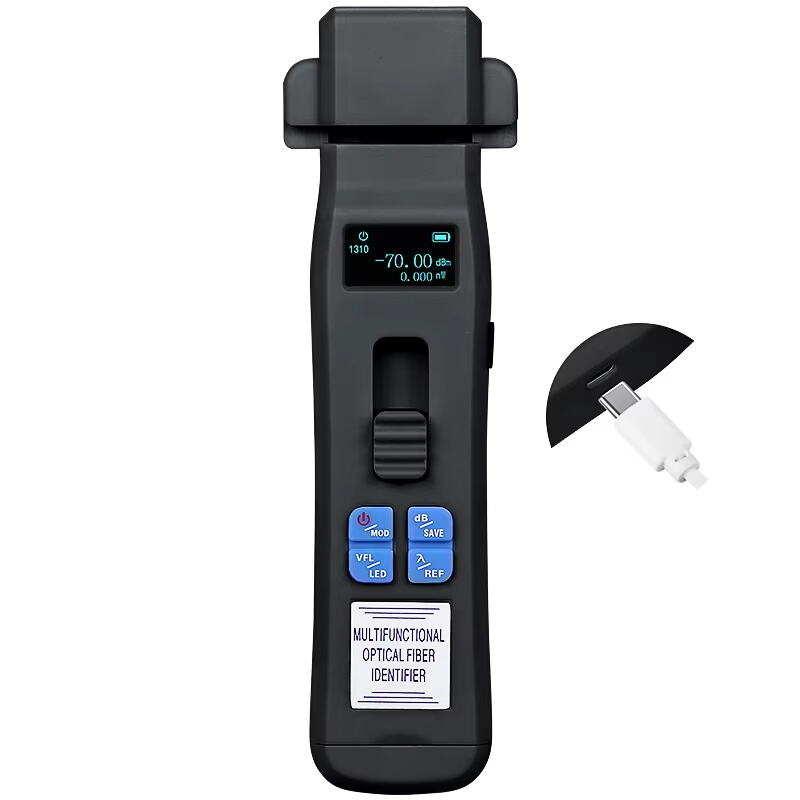Introduction: The Critical Role of Fiber Optic Identifiers in Network Maintenance
Why Network Maintenance Efficiency Matters in Modern Infrastructure
Good network maintenance makes all the difference when it comes to reducing downtime, boosting performance, and keeping customers happy in our current high-speed environment. Companies that get serious about maintaining their networks tend to save money on operations over time. These maintenance approaches also mean services stay available longer, giving businesses an edge in markets where constant connection matters most. Take companies with well-maintained networks for example they regularly report uptime numbers way beyond what's typical across industries, which helps keep clients coming back. We need solid maintenance plans now more than ever because technology keeps advancing and people want faster access to more data than before. Tools like fiber optic identifiers have become essential in this landscape, providing accurate information that lets technicians fix problems quickly instead of wasting hours troubleshooting blind.
Defining Fiber Optic Identifiers and Their Core Functions
Fiber optic identifiers serve as handy tools for spotting, tracking down, and managing those pesky fiber optic cables in complex network setups, making maintenance work a whole lot easier. These devices come with key features such as detecting active fibers and finding where problems occur, helping keep networks running properly while stopping accidental damage that might cause service outages. When something goes wrong, these identifiers let techs find issues fast and check if fibers are live, so getting things back online happens quicker than waiting for coffee to brew. Plus, they play nice with existing network management systems, giving operators better visibility across their infrastructure and improving how different teams work together on fixes. For businesses dealing with fiber networks day in and day out, investing in good quality identifiers pays off big time, since it cuts down on downtime costs and keeps operations flowing smoothly without unexpected hiccups.
Improved Fault Detection with Fiber Optic Identifiers
Real-Time Monitoring for Rapid Issue Localization
Fiber optic identifiers give networks real time monitoring power that lets tech teams catch problems almost instantly, cutting down on the hours or days it usually takes to find and fix issues. When something goes wrong in the system, these quick responses mean fewer service interruptions for everyone connected, which keeps customers happy and maintains confidence in the network's stability. Research from telecom companies shows that businesses implementing this kind of monitoring tech actually cut their average repair time by around 30 percent compared to traditional methods. That kind of improvement adds up fast when looking at monthly maintenance costs across large scale operations. For service providers trying to stay ahead in today's market, investing in better monitoring isn't just smart business it's becoming essential for staying competitive against rivals who might be lagging behind.
Minimizing Service Disruption During Diagnostics
Fiber optic identifiers really help out when doing network diagnostics because they don't interrupt service at all. Networks can keep running normally even while technicians work on them. The trick is using methods such as live deactivation for checking things out, which means customers hardly notice anything happening during their regular maintenance sessions. Companies that have started doing this report around a 20 something percent drop in complaints about service problems during these maintenance periods. So basically, having good fiber optic tools makes maintenance smooth sailing and helps maintain those top notch service levels that customers expect nowadays.
Case Study: Reducing Downtime in Underground Fiber Networks
An interesting example from a city environment shows how fiber optic markers can really cut down on time lost during network repairs. When one underground fiber system started using these new identification tools, they saw their troubleshooting time drop dramatically—from around 12 hours down to just 2 hours, which represents roughly an 80 something percent reduction. What this tells us is that good tech makes all the difference when it comes to keeping networks running smoothly without constant interruptions. The practical benefit here isn't just faster fixes but also fewer headaches for customers who depend on reliable connectivity day after day.
Enhanced Accuracy in Fiber Troubleshooting Processes
Live Fiber Identification to Prevent Accidental Damage
Being able to identify live fibers while working on networks really helps avoid accidental damage during troubleshooting, which protects good fibers from getting messed up. Techs need this capability to tell apart active from inactive fibers, something that cuts down on service outages quite a bit. When companies implement proper fiber ID techniques, their networks stay stable even when maintenance work is going on. Some telecom firms actually saw around 40% fewer cases of accidental fiber damage after they started using these live identification methods regularly. Beyond just making networks more resilient, this practice keeps services running smoothly, which means customers don't get upset about unexpected downtime.
Mapping Network Pathways for Precision Repairs
Fiber optic identifiers are essential tools for creating accurate maps of network pathways, giving techs the ability to fix problems faster and with much better results. When we talk about mapping networks, it usually involves those digital templates that help visualize what's going on underground or behind walls. This makes finding issues so much easier and cuts down on how much work needs to be done during repairs. Businesses save money when they streamline their maintenance workflows because mistakes happen less often. Industry data shows that companies adopting proper mapping methods have cut down on wasted repair efforts by around 25%. For large organizations dealing with complicated network setups like data centers or telecom infrastructure, getting this right means huge savings over time while maintaining service quality standards across their operations.
Integration with AI-Driven Analytics for Error Reduction
When fiber optic identifiers get combined with AI analytics, it creates something pretty special for reducing mistakes in how we manage networks. The system looks at past data patterns and gives early warnings so technicians can fix problems before they blow up into bigger headaches. Networks equipped with this kind of smart tech actually spot issues way ahead of time, stopping service outages before they happen. Some research shows companies using these systems saw around half fewer repeat problems over six months. What makes this approach stand out is how adaptable it becomes. Network managers aren't just reacting anymore; they're planning for changes in traffic patterns, equipment wear and tear, even weather impacts on underground cables. This kind of forward thinking keeps operations running smoothly through all sorts of unexpected challenges.
Cost and Time Savings Through Optimized Maintenance
Reducing Labor Costs with Targeted Repair Strategies
Using Fiber Optic Identifiers for targeted repairs cuts down on labor expenses quite a bit. When technicians can pinpoint exactly where problems lie in the network, they don't waste time checking areas that are working fine. This means fewer man hours spent on unnecessary troubleshooting and less money paid out for overtime work. Some studies show companies that switched to this method actually cut their labor bills by around 30 percent. Beyond saving cash, this kind of focused maintenance makes operations run smoother too. Workers spend their time fixing real issues instead of chasing ghosts through the system.
Preventive Maintenance Enabled by Historical Data Trends
Looking at past data patterns helps businesses put together good preventive maintenance plans before expensive emergency fixes become necessary. Fiber optic identification tools play a big role in keeping tabs on how systems perform over time. These tools let technicians see what's going on inside the network so they can plan when maintenance should happen and where resources need to go. Research indicates that firms which stick to regular maintenance schedules experience about 60 percent fewer surprise breakdowns compared to those who don't. That kind of difference adds up to real money saved in the long run. Taking this forward thinking approach cuts down on system downtime, meaning networks stay online and working properly without constant interruptions.
ROI Analysis: Long-Term Financial Benefits
Looking at the return on investment for fiber optic identifiers shows real money saving potential over time. Companies that invest in these systems typically see better day-to-day operations, fewer interruptions when things go wrong, and spend less fixing problems down the road. According to what industry insiders are saying, most businesses get back twice what they spent within about two years after installing modern fiber optic identification tech. The numbers back this up pretty well too. For companies thinking about their bottom line while maintaining reliable networks, spending on quality fiber optic identifiers makes sense both financially and operationally in the long run.
FAQ Section: Fiber Optic Identifiers in Network Maintenance
What are fiber optic identifiers?
Fiber optic identifiers are tools used to detect, trace, and manage fiber optic cables within a network, enhancing maintenance processes.
How do fiber optic identifiers improve network maintenance?
They allow for real-time monitoring, fault detection, and diagnostics without service disruptions, significantly improving maintenance processes and reducing downtime.
What are the cost benefits of using fiber optic identifiers?
Organizations can reduce labor costs by up to 30%, avoid emergency repairs, and achieve significant savings, resulting in a high return on investment.
How do fiber optic identifiers integrate with AI-driven analytics?
By analyzing historical data, they offer predictive insights that help in proactive maintenance, reducing errors and avoiding disruptions.
Table of Contents
- Introduction: The Critical Role of Fiber Optic Identifiers in Network Maintenance
- Improved Fault Detection with Fiber Optic Identifiers
- Enhanced Accuracy in Fiber Troubleshooting Processes
- Cost and Time Savings Through Optimized Maintenance
- FAQ Section: Fiber Optic Identifiers in Network Maintenance







